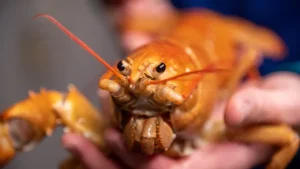A remarkable discovery was made by fishing crew Captain Gregg Turner in Casco Bay, off the coast of Maine. Among the vast number of lobsters found in the area, they came across an exceedingly rare specimen—an orange lobster. The chances of encountering such a vibrant creature are estimated to be one in thirty million, making it a truly exceptional find. To put this into perspective, the likelihood of discovering a blue lobster is one in two million, while encountering a split-colored lobster is an extraordinary one in fifty million occurrence.
This extraordinary orange lobster, now a resident of the University of New England, joins a collection of diverse and multicolored crustaceans. Its captivating coloration stands out among the typical mottled brown hue of most lobsters. According to experts at the university’s Marine Science Center, the lobster’s unique color is believed to be the result of a combination of genetic and environmental factors, although the exact mechanisms behind this phenomenon remain largely unknown.

Lindsay Forrette, a lab coordinator and chemical hygiene officer at UNE’s School of Marine and Environmental Programs, expressed her excitement about the discovery: “Rare lobsters, like this brilliant orange one caught by Turner’s Lobsters, are excellent ambassadors for education because they spark so much curiosity. Sharing these amazing animals with our students and visitors is a special opportunity that wouldn’t be possible without the Maine lobstering community all along the coast.”
Captain Gregg Turner, reflecting on his extensive career, revealed that this was only the second time he had encountered such a brightly colored lobster. Adding to its uniqueness, the lobster possesses only one claw, a characteristic often observed in wild lobsters.
Forrette speculated that the lobster may have lost its claw during an altercation with another lobster or fish. However, this incident provides a valuable opportunity for students to study limb regeneration in crustaceans. The progress of the lobster’s claw regrowth will be documented in real time, a research endeavor that has been undertaken only once before with another resident lobster named Banana—a female yellow lobster.
Although the age of the orange lobster remains unknown, it is worth noting that lobsters typically reach restaurant-sized proportions at around 5 to 7 years old. If left undisturbed by human interference, these fascinating creatures can live up to approximately 100 years.
Now settled in its new tank, the next step for this remarkable lobster is to be given a name, just like its fellow crustaceans at the University of New England. In 2019, the university received a blue lobster affectionately nicknamed Blueberry, and in 2021, a yellow lobster named Banana joined the collection.
Images: FoxWeather
Source: FoxWeather





